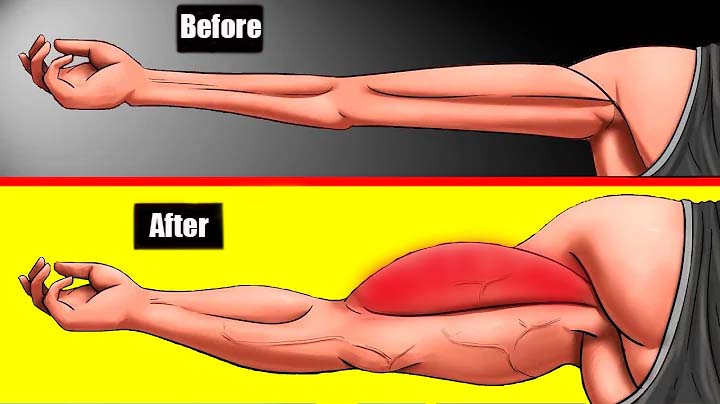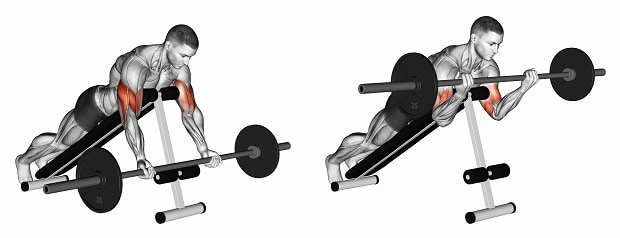10 Best Bicep Workout for Grow Muscle
For many athletes, the arms noticeably lag in growth from large muscle groups. There can be several reasons: excessive enthusiasm for only basic exercises, or, conversely, too much isolating work on the hands, which already work in all presses and rows.
If you want to pump up the biceps and triceps, you need to correctly combine basic exercises and isolating exercises for the hands. From the article, you will learn about the features of such exercises and the correct technique for their implementation, and we will also offer several training programs.
Before considering exercises for arm growth, let’s turn to anatomy. This is necessary to understand the specifics of the considered muscle group.
The Structure of the Muscles of the Hand
| Muscle | Muscle Antagonist |
| Biceps flexor muscle (biceps) | Triceps extensor (triceps) |
| Wrist flexor muscles | The extensor muscles of the wrist |
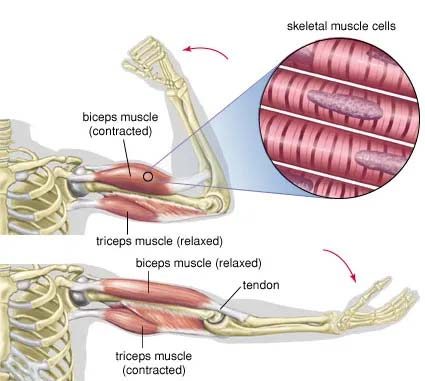
The arms are a massive amount of musculature distributed over many small muscle groups. It will not work to pump them all at the same time due to the structural features. Therefore, on the hands, you need to perform various exercises from different angles to work out the deepest fibers.
As a rule, when it comes to arm training, they mean exactly biceps and triceps. The muscles of the forearm are trained separately or not trained at all – usually, they develop harmoniously with the hands.
Training Tips
Due to the small size of the muscles and the possibility of cheating in the exercises, there are the following recommendations for training:
- You can train in complex and pump antagonist muscles, for example, back training is perfectly compatible with biceps training. Chest muscles are perfectly compatible with the triceps. A comprehensive workout will allow you to combine isolating exercises with basic ones.
- You can also set aside a separate day for arm training where we pump biceps and triceps, but this type of training is suitable for experienced athletes. After a day of hands, be sure to take a day of rest from training, let the muscles recover.
- When you combine exercises, such as doing 3-4 chest exercises, you can add 1-2 triceps exercises, also with a back workout. Do not do more exercises on the antagonist muscles (biceps or triceps) by training them on the same day with large muscle groups, this will lead to overtraining and the opposite effect.
- Train your biceps in a high rep style of 12-15 reps. You can also set aside one week of strength training where you train in a high-rep style, and the next week you do strength training in an 8-12 rep style with maximum weights.
- Do exercises with technique. Cheating is possible when you lift a lot of weight, but this is more suitable for professional athletes.
These techniques are best used when reaching a certain plateau in mass gain, already having experience in strength training and decent working weights.
The Best Biceps Exercises
The biceps are a target muscle group for many athletes. Consider typical exercises for pumping the biceps. Form an individual complex based on the workouts we have proposed.
1. Barbell curl

The most common exercise for this muscle group. Although many consider it basic, it is insulating – only the elbow joint works. However, it is quite effective if done correctly:
- Take the bar in your hands. The barbell can be used either straight or curved, it all depends on your preferences. Many people experience discomfort in their wrists when lifting with a straight bar.
- Stand straight, feet shoulder-width apart.
- As you exhale, bend your arms at the elbow joint due to the efforts of the biceps, trying not to move your back and not bring your arms forward. Do not use cheating, don’t swing your body.
- In the upper phase of the amplitude, linger for 1-2 seconds. At the same time, strain your biceps as much as possible.
- Slowly lower the projectile without fully extending your arms. Immediately begin the next repetition.
Why can’t you fully extend your arms? It’s all about the joint resistance that needs to be overcome when lifting again. By completely lowering your arms, you are not training muscles, but ligaments and tendons. Another reason is that the biceps will rest at this point. It is better when he is under load all the time of the approach.
2. Standing and Sitting Dumbbell Curl
The advantage of dumbbells over barbells is that you can work your arms separately, concentrating more on each of them. Such curl can be performed while standing (it will turn out to be almost an analog of the previous exercise) and sitting, moreover, on an inclined bench. The last option is the most effective since the biceps are in tension even with the arms lowered.

Technique:
- Place the bench at a 45-60 degree angle.
- Take dumbbells and sit down. The grip is supinated, that is, the palms initially look away from the body and their position does not change.
- As you exhale, curl your arms at the same time, while fixing your elbows and not moving them forward.
- Hold the peak contraction for 1-2 seconds.
- Lower the dumbbell under control without extending your arms to the end.
You can also do this exercise alternately with your left and right hand. We also allow a variant with a neutral grip in the starting position and supination of the hand during lifting.
3. Scott Bench Curl
The advantage of this exercise is the impossibility of cheating. You firmly rest against the simulator with your chest and triceps, and during the rise, you should not take your hands off it. Thanks to this design, only the biceps work here. To exclude the help of the muscles of the forearm at the same time, take an open grip.
The movement can be performed with either a barbell or a dumbbell. Choose the most convenient option for yourself or just alternate them from workout to workout.
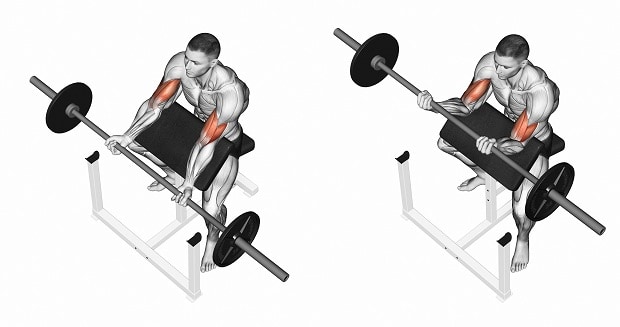
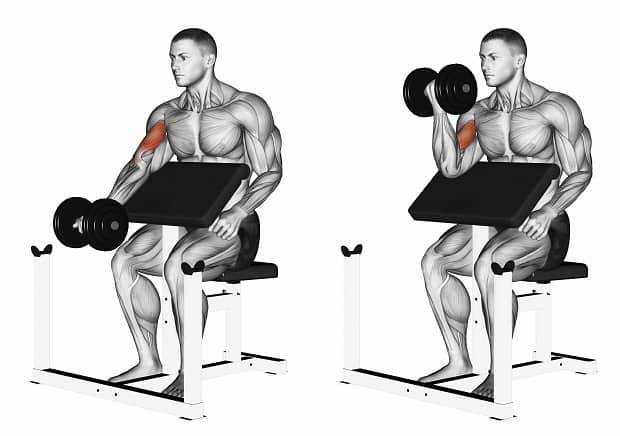
4. Close Grip Reverse Pull-Up
The only basic exercise for the biceps – two joints work here (elbow and shoulder), and the back muscles are actively included. It is quite difficult for many to learn how to pull themselves up only at the expense of their hands, so this exercise is rarely found in complexes. Fortunately, the biceps need to be isolated and used with basic rows when training the back to successfully work out.
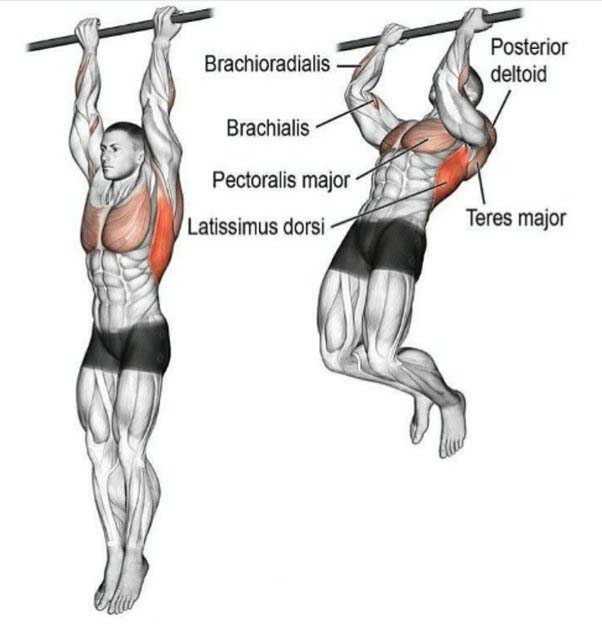
To engage the muscle group we need as much as possible, perform pull-ups as follows:
- Hang from the horizontal bar with a narrow reverse grip. Since the brushes are supinated, a large load will come precisely on the biceps. Straps do not need to be used. The wider the grip, the more emphasis goes on the lats.
- Pull yourself up by bending your arms at the elbows. Try to focus on this movement. The chin should be above the bar.
- Hold this position for 1-2 seconds, tensing your biceps as much as possible.
- Slowly lower yourself down.
5. Reversed Incline Bench Barbell Curls
Another great exercise for the biceps. Cheating is also excluded here since the body is fixed on the bench (it must be set at an angle of 30-45 degrees and lie down with your chest). The only thing left to watch is the elbows, which do not need to be brought forward when lifting.
The rest of the technique is similar to the usual barbell curls for the biceps. However, the working weight here will be less.
6. Dumbbell Concentrated Curls
A good exercise, as a rule, is performed with a small weight, since large dumbbells require fairly strong arms and biceps. It is better to take less weight, but to move clearly and without the slightest cheating – then the load will go exactly to the muscle group we need.
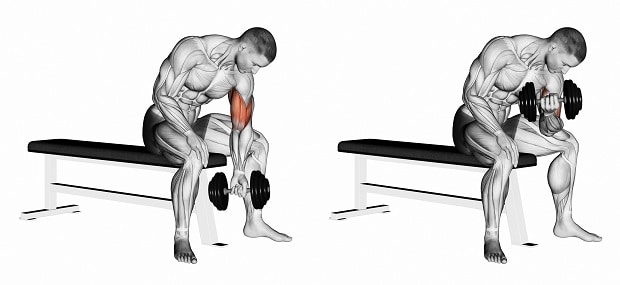
Technique:
- Sit on a bench, and spread your legs apart so that they do not interfere with the lift.
- Take a dumbbell in your left hand, and rest your elbow on the thigh of the same name. With your other hand, lean on your right leg for stability.
- Bend your arm with the force of the biceps of the arm. Fix the peak contraction.
- Under control lower it down without unbending it to the end.
7. Biceps Cable Curl
Many athletes like this exercise, as the hands here are in an atypical position for pumping biceps – they are raised to parallel with the floor. This allows you to load the muscles from a slightly different angle and diversify the training. It is best to put these bends at the end of the workout.
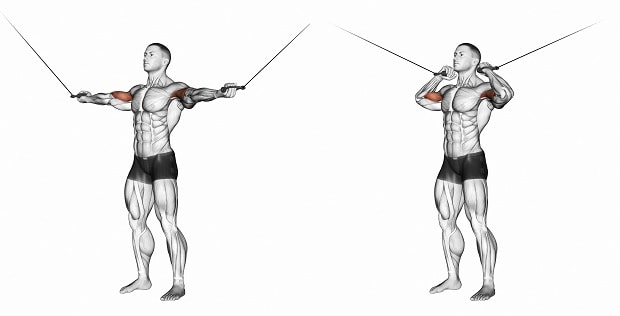
Technique :
- Take both upper crossover handles – left in the left hand, right in right. Stand between the racks of the simulator sideways to them.
- Raise your arms so that they are perpendicular to the body and parallel to the floor.
- At the same time, bend your arms, while fixing the position of the elbows and not raising them.
- At the peak point, squeeze the biceps as much as possible for 1-2 seconds.
- Slowly extend your arms (not all the way) and immediately begin the next repetition.
8. Low Cable Curl
Lower block or lower handle cable curls are a good option to complete your biceps workout. As a rule, this exercise is performed in a fairly high number of repetitions – 12-15, and its main purpose is to “finish off” the biceps muscle and properly fill it with blood.
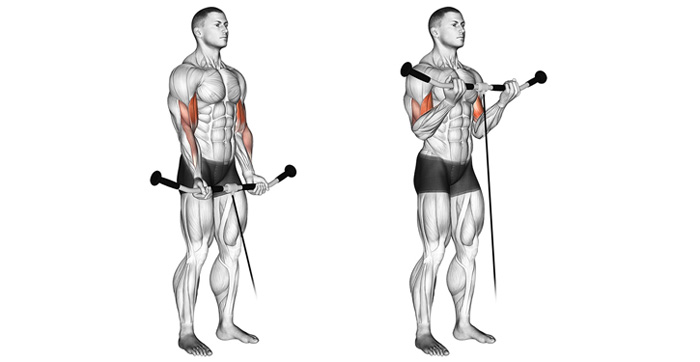
The technique is simple and similar to a regular barbell lift, only a special handle is used instead of a neck. You need to stand not close to the block, but slightly move away from it, so that the biceps are already under load in the lower position.
The movement can be performed with two hands with a straight handle:
Or do it one by one with one hand:
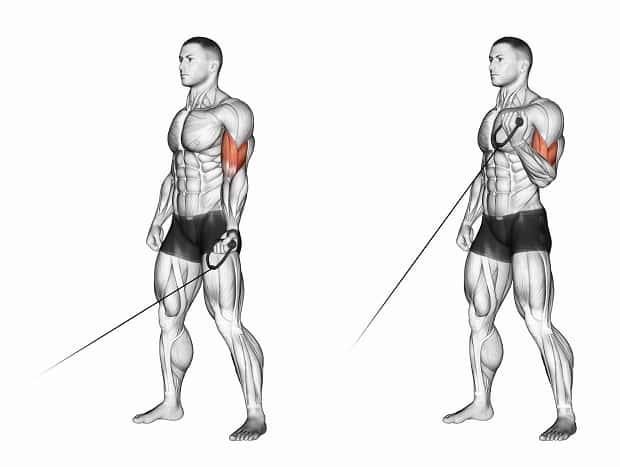
9. Hammers
To increase the volume of the arms, you must not forget to pump the shoulder muscle (brachialis), located under the biceps. With hypertrophy, it seems to push out the biceps of the shoulder, which leads to an actual increase in the girth of the arms.
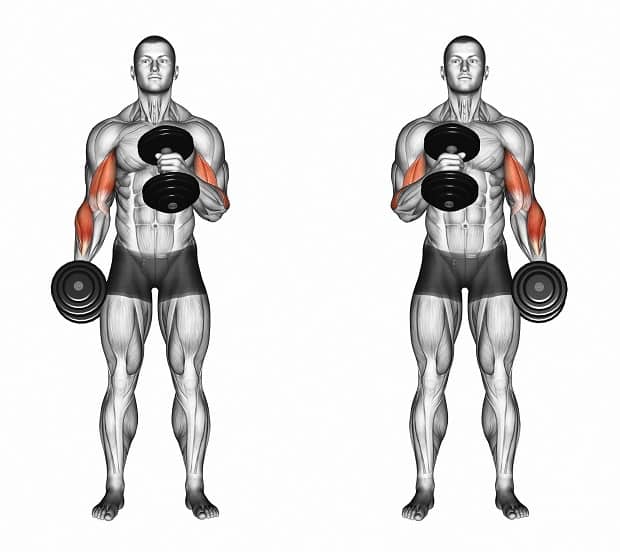
The most effective exercises for this muscle are neutral dumbbell curls or with a special barbell (palms facing each other):

Hammers are an exercise performed with a neutral grip. Most often it is done with dumbbells – the technique completely copies the usual dumbbell curl, only the grip is different. You can perform both standing and sitting.
10. Reverse EZ bar Curl
Another exercise for the brachial and brachioradialis muscles. Identical to straight grip lifts, only the weight will be slightly less.
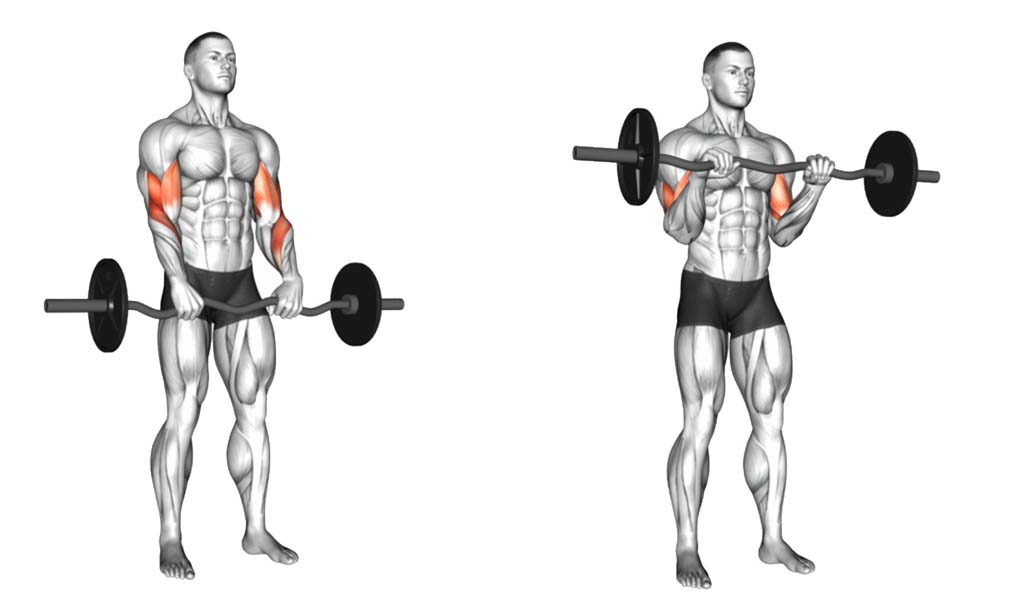
Reverse bicep curls can be performed with both a Z-barbell and a straight barbell.
Technique
- Grasp the bar with a reverse grip with your palms to the floor, the grip is closed.
- Start curling the barbell until the biceps rests on the forearm.
- Lower the barbell without fully extending your arms, your brachialis and biceps should be in constant tension.
- Complete the needed number of repetitions.
Biceps Program Grow
| Monday (chest + triceps) |
| Barbell Press | 4х12,10,8,6 |
| Incline dumbbell bench press | 3х10 |
| Push-ups on the Uneven Bars | 3х10-15 |
| Incline Dumbbell Fly | 3х12 |
| Close-Grip Bench Press | 4х10 |
| French bench press | 4х12-15 |
| Wednesday (back + biceps) |
| Wide grip pull-ups | 4х10-15 |
| Barbell Row | 4х10 |
| Reverse Grip Lat Pulldown | 3х10 |
| One Handed Dumbbell Row | 3х10 |
| Standing barbell curls | 4х10-12 |
| Incline dumbbell hammer curl | 4х10 |
| Friday (legs + shoulders) |
| Barbell Squat | 4х12,10,8,6 |
| Leg Press | 4х10-12 |
| Romanian deadlift | 4х10-12 |
| Rise On Toes Standing Simulator | 4х12-15 |
| Shoulder Press | 4х10-12 |
| Wide-grip upright row | 4х12-15 |
| Dumbbell Fly | 4х12-15 |
Experienced athletes can train biceps and triceps as a separate muscle group for 2-3 months.
Conclusions
We have reviewed the 10 best bicep exercises that are suitable for both beginners and advanced athletes. Try to alternate exercises week after week. Also, don’t forget to alternate strength days with days when you’re doing 50 percent of your max weight.
Source:
https://www.acefitness.org/resources/everyone/exercise-library/44/seated-biceps-curl/
https://link.springer.com/article/10.1007/s00167-018-5007-2

